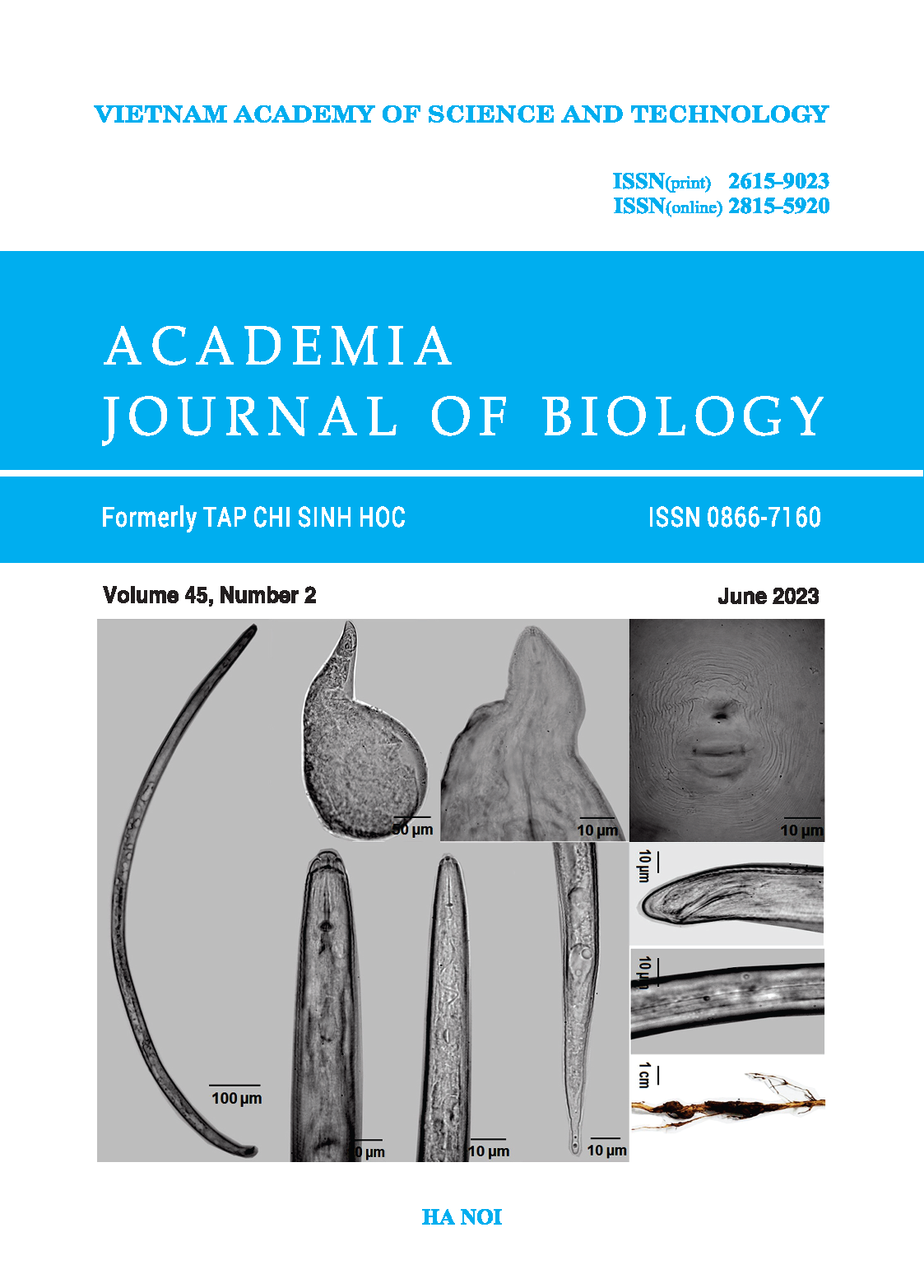Antimicrobial and antioxidant activities of \(\textit{Antheroporum harmandii}\) Gagnep. collected from Quang Tri province
Author affiliations
DOI:
https://doi.org/10.15625/2615-9023/18054Keywords:
Antheroporum harmandii, anti-microbial activity, anti-bacterial activity, natural compoundsAbstract
Antheroporum harmandii Gagnep. is a native plant species of Vietnam, belonging to a small genus of the Fabaceae family. In this study, the bioactivities of different extracts from twigs and seeds of A. harmandii plants collected from Dakrong, Quang Tri province were evaluated. Antimicrobial and antioxidant activities of plant extracts had been done using an agar well diffusion method and DPPH assay. The results showed that methanol, dichloromethane and ethyl acetate extracts from twigs and methanol extract from seeds exerted activities to significantly inhibit two out of nine tested microorganisms. Particularly, the dichloromethane extract from the twigs sample exhibited the highest activity to Micrococcus luteus and Staphylococcus aureus strains with inhibition zones of 4.7 ± 0.3 mm and 2.3 ± 0.2 mm, respectively, at concentrations of 50 mg/mL. The lowest MIC values (500 µg/mL) and 50% inhibition concentration values (IC50) against M. luteus and S. aureus were recorded for the methanol and dichloromethane extracts of twigs. Among tested extracts, the ethyl acetate extract of twigs was the strongest antioxidant, showing radical scavenging potential with IC50 of 117.24 μg/mL. Therefore, A. harmandii species can be suggested as a new source for the isolation of valuable natural compounds.
Downloads
References
Evans S. V., Fellows L. E., Bell E. A., 1985. Distribution and systematic significance of basic non-protein amino acids and amines in the Tephrosieae. Biochemical Systematics and Ecology, 13: 271–302.
Gagnepain F., 1915. Antheroporum, gen. nov. Notulae Systematicae (Paris) 3: 180–182.
Gao S., Xu Y. M., Valeriote F. A., Gunatilaka A. A., 2011. Pierreiones A-D, solid tumor selective pyranoisoflavones and other cytotoxic constituents from Antheroporum pierrei. Journal of Natural Products, 74 (4): 852–856. https://doi.org/10.1021/np100763p
Hadacek F., Greger H., 2000. Testing of antifungal natural products: methodologies, comparability of results and assay choice. Phytochemical Analysis, 11: 137–147. https://doi.org/10.1002/(SICI)1099-1565(200005/06)11:3<137:AID-PCA514>3.0.CO;2-I
Havyarimana L., Ndendoung S. T., de Dieu Tamokou J., de Théodore Atchadé A., & Mbafor Tanyi J., 2012. Chemical constituents of Millettia barteri and their antimicrobial and antioxidant activities Pharmaceutical Biology, 50(2): 141–146. https://doi.org/10.3109/13880209.2011.579618
Kedare S. B., Singh R. P., 2011. Genesis and development of DPPH method of antioxidant assay. Journal of Food Science and Technology, 48: 412–22. https://doi.org/10.1007/s13197-011-0251-1
Marco M., Deyou, T. G., Holleran A., Duffy S., Heydenreich M., Firtzpatrick
P. A., Landberg G., Koch A., Derese S., Pelletier J., Avery V. M., Erdélyi M., Yenesew, A., 2017. Pterocarpans and isoflavones from the root bark of Millettia micans and of Millettia dura. Phytochemistry Letters, 21: 216–220. https://doi.org/10.1016/j.phytol.2017.07.012
Mattapha S. & Tetsana N., 2021. Antheroporum puudjaae (Millettieae: Fabaceae), a new species from Thailand. Thai Forest Bulletin Botany, 49(1):
–134. https://doi.org/10.20531/tfb.2021.49.1.16
Mensor L. L., Menezes F. S., Leitão G. G., Reis A. S., dos Santos T. C., Coube C. S., Leitão S. G., 2001. Screening of Brazilian plant extracts for antioxidant activity by the use of DPPH free radical method. Phytotherapy Research, 15(2): 127–130. https://doi.org/10.1002/ptr.687
Prasad S. & Tyagi A. K., 2015. Traditional medicine: The goldmine for modern drugs. Advanced Techniques in Biology & Medicine: 03. https://doi.org/10.4172/2379-1764.1000e108
Stańczyk M., Gromadzińska J., Wasowicz, W., 2005. Roles of reactive oxygen species and selected antioxidants in regulation of cellular metabolism. International Journal of Occupational and Environmental Health, 18: 15–26.
Tungmunnithum D., Drouet S., Lorenzo J. M., Hano C., 2021. Characterization of bioactive phenolics and antioxidant capacity of edible bean extracts of 50 Fabaceae populations grown in Thailand. Foods, 10 (12): 3118.
Wiegand I., Hilpert K., Hancock R. E. W., 2008. Agar and broth dilution methods to determine the minimal inhibitory concentration (MIC) of antimicrobial substances. Nature Protocols, 3(2): 163–175. https://doi:10.1038/nprot.2007.521
Downloads
Published
How to Cite
Issue
Section
License
Academia Journal of Biology (AJB) is an open-access and peer-reviewed journal. The articles published in the AJB are licensed under a Creative Commons Attribution-NonCommercial-NoDerivatives 4.0 International License (CC BY-NC-ND 4.0), which permits for immediate free access to the articles to read, download, copy, non-commercial use, distribution and reproduction in any medium, provided the work is properly cited (with a link to the formal publication through the relevant DOI), and without subscription charges or registration barriers. The full details of the CC BY-NC-ND 4.0 License are available at https://creativecommons.org/licenses/by-nc-nd/4.0/.












